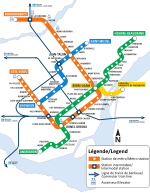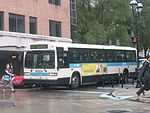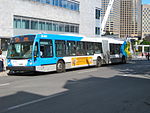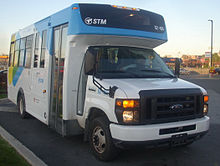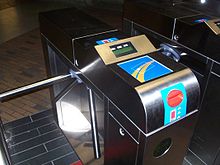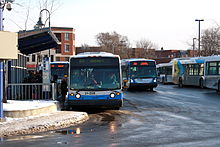- Société de transport de Montréal
-
Société de transport de Montréal
(Montreal Transit Corporation)
Bottom: Montreal's first two mayors, Jacques Viger and Peter McGill, in stained glass in the McGill Station of the Montreal Metro.
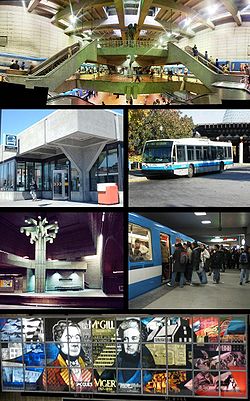
Top: Lionel-Groulx metro station and 2010 STM logo. Prior to 2002, it was referred to as STCUM. Second row: Honoré-Beaugrand metro station, a 1996 NovaBus LFS "167 Le Casino" leaving the Montreal Biosphère and heading to the Casino de Montréal. Third row: Georges-Vanier metro station, Berri-UQAM metro station.Info Locale Agglomeration of Montreal Transit type Local bus and subway transit Number of lines 197 bus routes + 23 night routes, 4 subway lines (1 – green, 2 – orange, 4 – yellow and 5 – blue)[1] Number of stations 68[1] Daily ridership 2,524,500 (avg. weekday 2011) [2] Chief executive Yves Devin Headquarters 800 rue de la Gauchetière Ouest Montreal QC H5A 1J6
CanadaOperation Began operation 2002 Operator(s) Société de transport de Montréal The Société de transport de Montréal (English: Montreal Transit Corporation) is a public transport agency that operates transit bus, and rapid transit services in Montreal, Quebec, Canada. Established in 1861 as Montreal City Passenger Railway Company, and STM as of 2002, it has grown to comprise four metro lines with a total of 68 stations, as well as over 186 bus routes and 23 night routes.
The STM operates the third most heavily used urban mass transit system in North America, after the New York City Transit Authority, and the Mexico City Metro.[2] As of 2011, the average daily ridership is 2,524,500 passengers: 1,403,700 by bus, 1,111,700 by rapid transit and 9,200 by paratransit service.[2]
Contents
Transit modes
Metro
Main article: Montreal MetroThe Montreal Metro subway system was introduced in 1966 in preparation for Canada's 100th birthday and the Expo 67 World Fair in Montreal. Instead of traditional steel-wheeled trains, it is a rubber-tired metro, based on technology developed for the Paris Métro; Montreal's system was the first in the world to be entirely rubber-tired. The metro system is currently Canada's busiest subway system in total daily passenger usage, serving an average of 1,111,700 daily passengers on an average weekday.[2] In 2010, 296.3 million riders (transfers not included) used the Metro.[3] According to the STM website the metro system has transported over 7 billion passengers as of 2010, roughly equivalent to the world's population.
Montreal Metro lines:
Bus services
Main article: List of Montreal Bus RoutesThe STM bus service, consists of 197 daytime and 23 nighttime service routes that provide a vast number of routes for the city of Montreal proper. STM bus routes serve an average of 1,403,700 daily passengers on an average weekday in 2011.[2]
Regular bus routes, which usually operate from 4:40 AM to 1:30 AM from Monday to Saturday and from 5:00 AM to 1:00 AM on Sundays, Night Routes usually operate from 1:00AM to 5:00AM from Mondays to Sundays depending on the route, some only operate on the nights of Fridays and Saturdays. The STM also operates express routes during rush hours only, special routes termed Metrobus, and Trainbus, are bus routes that lead from a specific terminus and run only a few stops to get passengers to a Metro or Commuter Train station as fast as possible. Reserve Lane Routes operate during rush hour only. Many connections are also available to suburban transit agencies.
The city of Montreal has announced a plan to convert its entire fleet of buses over to all-electric by 2025. Beginning in 2012, all STM bus purchases will be either hybrids or electrics and, starting in 2011, Montreal will begin testing trolleybuses (electric buses powered by overhead wires) on some of the city's busiest routes[4]
The current STM bus fleet consists of 1,845 Novabus LFS and MCI/Nova Bus Classic buses. The entire fleet is equipped with GFI Oddysey fareboxes replacing the old Cleveland fareboxes as of December 2005. The livery on buses between 1991 and 2008 are white with a blue horizontal strip on the lower part of the bus. The new livery on all buses from 2009 and on, feature a new blue and white livery, the front of the bus is blue and the rest of the bus is white with two large overlapping chevrons near the rear on each side. One chevron is blue, the other is yellow, and where they overlap is green. All newer buses are equipped with interior CCTV cameras.
On August 30, 2010, the STM introduced the 10 Minutes Max network, this network provide buses at maximum intervals of 10 minutes or less, between 6 a.m. and 9 p.m., Monday to Friday, on the 31 of the STM's busiest bus routes.[5]
Current Vehicles
The STM operates over 1,800 buses in its fleet.
Photo Manufacturer Years Model Remarks Fleet numbers Nova Bus 1993–1995 TC40-102N Classic - Exit from service 2012-2014.
13-001 to 15-140 
Nova Bus 1995–1998 LFS First Generation 16-001 to 18-096 
Nova Bus 2001–2004 LFS Second Generation 21-202 to 24-307 
Nova Bus 2005–2009 LFS Second Generation 25-201 to 29-071 
Nova Bus 2008 LFS HEV 28-701 to 28-708 
Nova Bus 2009–present LFS Thrid Generation 29-072 to 31-XXX Nova Bus 2009–present LFS Artic 29-801 to 31-862 Taxibus
The STM also operates ten taxibus lines where the creation of regular bus service is not feasible. Regular STM fares apply, except that no cash is accepted.[6]
- Baie-d'Urfé, connecting to Baie-d'Urfé commuter railway station
- Stewart Hall, connecting to various locations in Pointe-Claire
- Île-des-Soeurs, connecting to Place du Commerce
- Lachine, connecting to Lachine commuter railway station
- L'Île-Bizard, connecting to bus route 265 Trainbus Île-Bizard
- Norman, connecting Lachine's residential neighborhoods to the industrial area north of Highway 20
- Lachine Industrial Park, connecting to Dorval commuter railway station
- Phillips Avenue (Senneville), connecting to bus route 210 John Abbott
- Sainte-Anne-de-Bellevue, Sainte-Marie district, connecting to Sainte-Anne-de-Bellevue commuter railway station
- Senneville, connecting to Sainte-Anne-de-Bellevue commuter railway station
- Montreal Technoparc, connecting to Sunnybrooke commuter railway station
Paratransit Service
The Société de Transport de Montréal operates a paratransit service for people with mobility problems. The lack of subway accessibility is critical for people whose mobility needs cannot be accommodated by stairs. STM's adapted transit is a system based on reservation, meaning that there is no room for flexibility. All trips must be booked at least one day in advance. Service began in April 1980. In first quarter, 2011, 9,200 trips were made through this service daily.[2]
Services
Fares
The STM fare system accepts cash, tickets (for Students and Seniors), and transit passes. As of January 1, 2011, adult cash fares are $3.00 for a single trip. Day passes available by the day $8, for 3 days at $16, a week $22, or month $72.75. Student or senior cash fares are $2.00 for a single trip. Student/senior weekly passes are sold for $12.75 and monthly passes for $41. Child cash fare is free for ages 5 and younger. The $8 day pass is valid for one adult and 5 youths (up to age of 19) or 2 adults and up to 4 youths on the weekends or holidays. There is a $4.00 unlimited evening pass, valid from 5PM to 6AM. Transfers are free (for trips in one direction). Transfers must be used within a 120 minute period.
On April 21, 2008, the STM unveiled the contactless smart card called OPUS (a play on the French phrase au puce, which is the word for the chip used in the cards) as a means of fare payment. In preparation for this new step in Montreal's public transportation network, turnstiles which incorporate the reader and automated vending machines had already been installed in metro stations; buses had previously been fitted with new fare boxes that incorporate the card reader, in order to ensure the uniformity of methods of payment across Montreal's transit network and that of its suburbs.
One advantage to the smart card compared to the previous system is the seamless integration with other transit networks of neighbouring cities, eliminating the need to carry small change or purchase different tickets. The same can be said of the commuter train service, run by the Agence métropolitaine de transport, that requires the purchasing of a ticket different from those offered by the STM. Another advantage relates to the speed at which users can access the system. As opposed to the magnetic stripe cards previously in use, which have been sold alongside the new OPUS cards up until May 2009, the contactless smart card is more user-friendly in that not only will the card not risk becoming demagnetized and rendered useless, but it also does not require patrons to slide the card in a particular way—proximity to the contactless reader will suffice.
Costs to the STM related to the project are approximately $138 million, compared to the original estimated cost of some $100 million. The project was originally supposed to be implemented in 2006.
Schedules and route information
Route information can be accessed through the STM AUTOBUS number at 514-288-6287. Individual route schedules are available online at STM.info. Google Maps supports the STM.
In July 2009 the STM set up an SMS service that show uses the bus schedules, the planned opening and closing times of the metro and informs of any delays in the metro or bus service.[7]
In 2014 the STM will introduce iBus, a real-time GPS tracking system. It will include electronic signs inside buses showing the estimated time of arrival at upcoming stops and the busiest bus stops will have electronic signs showing the estimated time of arrival of the next bus.[8]
A handful of stations are equipped with the MétroVision information screens which displays advertising, news headlines and weather information from RDI and the Weather Network, as well as STM-specific information regarding service changes, service delays and information pertaining to using the system. By the end of 2015 the STM plannes to have the screens in all 68 metro stations.
Accessibility
All 197 daytime bus routes and 23 night routes are wheelchair accessible. However on 1 out of the 4 metro lines are accessible to wheelchairs. The Orange line has 8 stations with elevators installed : Côte-Vertu, Lionel-Groulx, Bonaventure, Berri-UQAM , Henri-Bourassa, Cartier, De La Concorde, Montmorency. Two additional stations are to have elevators installed by 2016.[9]
Infrastructure
Terminus
Buses loading passengers at Terminus Côte-Vertu.
Most STM bus routes terminate at loops, side streets or metro stations.
Terminus with a large amounts of bus routes from the STM and other transit agencies in Greater Montreal.
- Terminus Angrignon
- Terminus Côte-Vertu
- Terminus Dorval
- Terminus Fairview
- Terminus Henri-Bourassa Nord
- Terminus Henri-Bourassa Sud
- Terminus Honoré-Beaugrand
- Terminus Radisson
Other smaller STM loops/ terminus include:
- Terminus Atwater
- Beaubien Loop
- Crémazie Loop
- Terminus Jolicoeur
- Terminus Lafleur-Newman
- Laurier Loop
- Terminus MacDonald
- Rosemont Loop
- Terminus Sherbrooke-East
- Villa Maria Loop
- Terminus Vendôme
Facilities
STM buses are operated out of a number of garages located around the city and metro trains are serviced several other facilities. The surface routes are divided into several divisions. Individual divisions have a superintendent, an on-duty mobile supervisor, a communications centre, and a garage facility tasked with managing the division's vehicle fleet and routes. Metro trains are stored in four garages and maintenance is carried out in three different facilities along the network.
Bus Garages Anjou Crémazie Frontenac LaSalle Legendre Mont-Royal Stinson (2013) St-Denis St-Laurent St-Michel (Paratransit) Metro Train Garages Angrignon Beaugrand Montmorency Saint-Charles Metro train maintenance facilities Duvernay Plateau d'Youville Viau Stops and shelters
There are 8,500 bus stops in the STM network. Each stop has a panel that indicates the number of routes that stops there, the type of service, if the bus goes to a metro or train station and the bus stop code enabling you to obtain the schedule by telephone at 514-AUTO-BUS. The STM is in the process of changing all its bus stop panels to a new modern pole that displays the route numbers. The route number is color coded for the type of service it offers, dark blue is for regular routes, green is for express, metrobus and R-bus routes, black for night routes and gold for senior shuttles . Almost every stop has a bus shelter. Adverting is provided by CBS. On November 8, 2010 the STM lunched 3 prototypes of modern bus shelters to replace the old ones. They will run on a solar power system and lights in the shelter are to be controlled by motion sensor.
History
Predecessor companies
Past Montreal transit agencies. [10]
Name Abriviation Start Year Finish Year Remarks Société de transport de la communauté urbaine de Montréal STCUM June 1985 December 2001 Commission de transport de la communauté urbaine de Montréal CTCUM January 1970 May 1985 Commission de transport de Montréal CTM January 1951 December 1969 Montreal Tramways Company MTR January 1911 December 1950 Montreal Street Railway Company MSRC January 1886 December 1910 Montreal City Passenger Railway Company MSR November 1861 December 1885 Streetcars
In the 19th and early 20th centuries, Montreal had streetcar service. On August 30, 1959, Montreal abandoned the last of its streetcars. Although there had been heavy traffic loads during the years of the Second World War, the American threat grew following the war. There was an unwanted growth in automobile ownership, which took a toll on streetcar passenger numbers. Increasing traffic congestion, especially on the narrow pedestrian streets of the historic sections of Montreal, made it increasingly difficult to provide good service by a "Detroit" type operation. The streetcar network also needed much rehabilitation work after heavy usage during the war years due to high demand, efficient performance and a perfect symbiosis with the city. The current absence of trams is conspicuous in Montreal; trams would be a welcome addition to the bus and metro lines, and are planned for re-development in certain areas.
The private Montreal Tramways Company's 30-year contract with the city was also came to an end in 1948. For all of these reasons, the company was reluctant to spend money on expansion and modernization. In 1950, legislation was passed to create the city-owned Montreal Transportation Commission, which would be charged with taking over the assets of the Montreal Tramways Company, which officially did so in June 1951. The Commission decided to convert all streetcar lines to buses within 10 years. To relieve traffic congestion, it decided to convert the inner city routes first. Many of Montreal's streetcar routes included running on a portion of Sainte-Catherine Street downtown. On some downtown sections of this street, there was a headway of 10 s or less between streetcars. By the end of August 1956, Sainte-Catherine Street was without streetcars. Many of the outlying routes, especially those running on private rights-of-way, lasted the longest. When the last streetcar ran in August 1959, the Commission had succeeded in replacing the streetcar system with buses in eight years instead of ten.
- Horsecar service 1861–1894
- Electric streetcar service 1894–1959
Since 1906, the system included a set of two (later four) special open-topped steetcars locally known as Golden Chariots. Ostensibly for tourists, they were probably always more popular with Montrealers looking for a breezy ride during the hot and humid summers of Montreal. Seating was arranged in an ascending configuration (like a theatre's tiered seats) toward the rear to provide a commanding view of the sights. They operated on a 10 mi (16 km) counter-clockwise circuit around the twin summits of Mount Royal via Bleury, Park, Laurier, Côte Sainte-Catherine, Bellingham, Maplewood, Decelles, Queen Mary, private right-of-way between Queen Mary and Côte Saint-Luc, Girouard, Sherbrooke, Greene, Sainte-Catherine, then back to Bleury.
A second Golden Chariot route was established in the late 1940s. That followed a counter-clockwise route along Ste. Catherine, Delormier, Mount Royal, Park, Laurier, Côte Sainte-Catherine, Bellingham, Maplewood, Decelles, Queen Mary, Côte-des-Neiges, and back to Sainte-Catherine. This second route lasted only a few years being discontinued when streetcar service ended on Cote des Neiges in 1955.
Contrary to popular belief, the Golden Chariots never operated in regular service over the mountain on the private right-of-way that later became the Camillien Houde Parkway for automobiles. It was found that if passengers stood in some areas of the upper tiers of the Golden Chariots, there was to little safety clearance in the tunnel on that line. Therefore, the Company decided against ever using the Golden Chariots in regular service on the spectacular mountain right-of-way except for occasional charter trips. Service was normally provided by the regular cars of the 11-Mountain and 93-Remembrance routes. Those cars were equipped with a variety of special safety devices for operation on this steep, sharply-curved line. Both of these routes were summer-only services.
By 1956, the Golden Chariot route had to be adjusted as streetcar trackage was reduced. When streetcar service ended on Sherbrooke and Sainte-Catherine in the late summer of 1956, cars were rerouted. Instead of turning east from Girouard to Sherbrooke, they continued south on Girouard to Upper Lachine Road, then Saint-Antoine to Park. They last ran in regular service in the summer of 1957 although they could still be chartered in the summer of 1958. By then, however, the streetcar track network had really shrunk. Existing examples of these unique vehicles can be seen in streetcar or railway museums (ones are known to be at the Canadian Railway Museum in Saint-Constant, Quebec and at the Connecticut Trolley Museum in East Windsor, Connecticut).
There were a number of other unique cars on the system especially in the earlier years. The company's predecessors operated a smaller two-axle version of the Golden Chariots. It was used as a rolling stage for the company's employee band. There was also a prison car that would take miscreants between the downtown courthouse and the outlying Bordeaux Prison. There were also two funeral cars, which saw heavy use during the influenza epidemic of the early 20th century. They were used to carry caskets to the outlying Hawthorn-dale Cemetery, which was beyond the reach of good roads at the time. The cars only carried caskets; mourners had to make their own way there.
Trolleybuses
Montreal also used trolleybuses. Introduced in 1937, they were seen as having some advantages over streetcars. Unlike streetcars, they could load and unload at the curb instead of stopping traffic in the middle of the street. They were still dependent on overhead trolley wires. Their passenger capacity was also less than the larger streetcars. Although all streetcar lines had been converted to buses by 1959, traffic congestion had not improveed as hoped. City traffic engineers came up with a plan to turn many major streets into one-way thoroughfares, which would affect several trolleybus routes. Trolleybuses by this time had fallen out of favour with transit companies, and new North American equipment was harder to get. Montreal's Brill trolleybuses were quickly approaching the end of their economic service lives. As a result of all of these factors, the Commission decided to end trolleybus service in June 1966. Montreal's new subway, the Metro, would open just four months later in October. Here are just some of the vehicles that served in Montreal:
Horsecars
Electric cars
- J. G. Brill Company DE ST Birney
- Brownell Car Company SE ST
- Canadian Car and Foundry SE DT, PCC
- Kuhlman SE DT
- Newburyport Car Manufacturing Company SE DT
- Ottawa Car Company SE DT
In February 2006, Montreal mayor Gérald Tremblay suggested the city look into a return of the streetcar into the heart of the city, following a visit to Paris, where new service is also in the planning stages.[citation needed]
Trolleybuses
- AEC (Associated Equipment Company) 664T
- Canadian Car & Foundry T-44, T-44A
Regional transit service
The STM was formerly involved in the operation of regional transit services. The first such service was a set of bus routes inherited from the October 1980 expropriation of a private bus company called Metropolitan Provincial (1967) Inc. These regional bus routes operated from downtown Montreal to the western part of the Island of Montreal, as well as to off-island points located west, south-west, and north east of the Island of Montreal. By the end of 1985, the STM (then known by the initials CTCUM) had exited the regional bus business to focus on its core territory (the Island of Montreal). Most of the regional bus routes were passed to private operators who provided services under contract to newly formed intermunicipal transit councils.
The second regional service involved the management of two commuter train lines. On July 1, 1982, the CTCUM and the Canadian National Railway (CN) entered into an agreement to integrate the Montreal-Deux Montagnes commuter train line into the regular CTCUM bus and metro network. The CTCUM paid CN to staff, run, and maintain the trains, while it set the fares and schedules. Passengers travelling within the CTCUM operating territory were able to transfer between the trains and the bus or metro, no fare supplement was required to make a bus/metro to train transfer . On October 1, 1982, a similar agreement with the Canadian Pacific Railway (CP) went into effect and CP's Montreal-Rigaud commuter train line was integrated into the CTCUM network.
On January 1, 1996, responsibility for the commuter trains was transferred to the AMT, a Quebec provincial government agency formed to coordinate all public transportation in the metropolitan Montreal region.
Connections to other transit services
STM is connected to surrounding transit agencies such as:
- Société de transport de Laval (STL) — City of Laval
- Réseau de transport de Longueuil (RTL) — City of Longueuil
- Agence métropolitaine de transport (AMT) — provides commuter rail service to Dorion-Rigaud, Deux-Montagnes, Blainville–Saint-Jérôme, Mont Saint Hilaire and Delson-Candiac.
- A number of intermunicipal transit organizations known as Conseil Intermunicipale de Transport (CITs) which provide service to suburban and rural areas such as Châteauguay, Salaberry-de-Valleyfield, Saint-Jean-sur-Richelieu, Saint-Hyacinthe, Sorel-Tracy, Repentigny, Terrebonne, and Saint-Jérôme.[11]
See also
References
- ^ a b Everything about the STM
- ^ a b c d e f http://www.apta.com/resources/statistics/Documents/Ridership/2011_q1_ridership_APTA.pdf
- ^ http://www.apta.com/resources/statistics/Documents/Ridership/2010_q4_ridership_APTA.pdf
- ^ http://green.autoblog.com/2010/05/24/montreals-bus-fleet-of-1-300-plus-going-all-electric-by-2025/
- ^ "Un bus toutes les 10 minutes, au maximum". Radio-canada.ca. http://www.radio-canada.ca/regions/Montreal/2010/08/25/004-stm-dix-minutes.shtml.
- ^ STM, Taxibus service
- ^ http://www.stm.info/English/info/comm-09/a-co090714.htm
- ^ http://www.montrealgazette.com/news/daily-commuter/With+iBus+transit+riders+will+have+real+time+tracking/5117056/story.html
- ^ http://24hmontreal.canoe.ca/24hmontreal/actualites/archives/2010/11/20101124-151648.html
- ^ [1]
- ^ AMT bus connections
External links
STM Bus Routes Standard Routes 15 Sainte-Catherine • 18 Beaubien • 24 Sherbrooke • 27 Boulevard Saint-Joseph • 32 Lacordaire • 33 Langelier • 44 Armand-Bombardier • 45 Papineau • 48 Perras • 49 Maurice-Duplessis • 51 Boulevard Édouard-Montpetit • 54 Charland/Chabanel • 55 Boulevard Saint-Laurent • 57 Pointe-Saint-Charles • 58 Wellington • 61 Wellington • 64 Grenet • 67 Saint-Michel • 69 Gouin • 78 Laurendeau • 80 Avenue du Parc • 90 Saint-Jacques • 95 Bélanger • 97 Mont-Royal • 99 Villeray • 100 Crémazie • 102 Somerled • 103 Monkland • 105 Sherbrooke • 106 Newman • 108 Bannantyne • 109 Boulevard Shevchenko • 110 Centrale • 112 Airlie • 113 Lapierre • 121 Sauvé/Côte-Vertu • 123 Dollard • 124 Victoria • 125 Ontario • 129 Côte-Sainte-Catherine • 132 Viau • 139 Pie-IX • 140 Fleury • 141 Jean Talon East • 161 Van Horne • 165 Côte-des-Neiges • 166 Queen Mary • 171 Henri-Bourassa • 187 René-Lévesque • 193 Jarry • 197 Rosemont • 211 Bord-du-LacExpress Routes 410 Express Notre-Dame • 420 Express NDG • 427 Express Saint-Joseph • 430 Express Pointe-aux-Trembles • 467 Express Saint-Michel • 470 Express Pierrefonds • 747 Express BusMetrobus Routes 143 Métrobus Charleroi • 148 Métrobus Maurice-Duplessis • 159 Métrobus Henri-BourassaReserved Lane Routes 505 Reserved Lane Pie-IX • 506 Reserved Lane Newman • 535 Reserve Lane Parc/Côte-des-NeigesNight Routes 350 Verdun/LaSalle • 353 Lacordaire/Maurice-Duplessis • 354 Sainte-Anne-de-Bellevue/Downtown • 355 Pie-IXBus rapid transit Line 1 Green Angrignon • Monk • Jolicoeur • Verdun • De L'Église • LaSalle • Charlevoix • Lionel-Groulx • Atwater • Guy-Concordia • Peel • McGill • Place-des-Arts • Saint-Laurent • Berri-UQAM • Beaudry • Papineau • Frontenac • Préfontaine • Joliette • Pie-IX • Viau • Assomption • Cadillac • Langelier • Radisson • Honoré-BeaugrandLine 2 Orange Côte-Vertu • Du Collège • De La Savane • Namur • Plamondon • Côte-Sainte-Catherine • Snowdon • Villa-Maria • Vendôme • Place-Saint-Henri • Lionel-Groulx • Georges-Vanier • Lucien-L'Allier • Bonaventure • Square-Victoria • Place-d'Armes • Champ-de-Mars • Berri-UQAM • Sherbrooke • Mont-Royal • Laurier • Rosemont • Beaubien • Jean-Talon • Jarry • Crémazie • Sauvé • Henri-Bourassa • Cartier • De La Concorde • MontmorencyLine 4 Yellow Line 5 Blue Snowdon • Côte-des-Neiges • Université-de-Montréal • Édouard-Montpetit • Outremont • Acadie • Parc • De Castelnau • Jean-Talon • Fabre • D'Iberville • Saint-MichelMontreal Features 
History Expo 67 · Hochelaga · Mayors · Montreal Urban Community · October Crisis · Oldest buildings and structures · Reorganization of Montreal · 1976 Summer Olympics · Timeline · National Historic Sites of CanadaGeography Economy Politics Public Services Education Commission scolaire de Montréal · Commission scolaire Marguerite-Bourgeoys · Concordia University · English Montreal School Board · Jewish Public Library · Lester B. Pearson School Board · List of schools and libraries · McGill University · Montreal Public Libraries Network · Université de Montréal · Université du Québec à MontréalCulture Architecture · Cuisine · Festivals and parades · Films · Media · Music groups · Shopping malls · Sport · TourismTransportation Aéroports de Montréal · Agence métropolitaine de transport · Bridges · Central Station · Gare d'autocars de Montreal · Metro · Montréal-Pierre Elliott Trudeau International Airport · Port of Montreal · Roads · Société de transport de MontréalCategories:- Agence métropolitaine de transport
- Transit agencies in Quebec
- Société de transport de Montréal
- Bus transport in Quebec
- Intermodal transport authorities in Canada
- Montreal Metro
- Crown corporations of Quebec
- Underground rapid transit in Canada
- Companies established in 2002
- Transit authorities with hybrid buses
Wikimedia Foundation. 2010.

